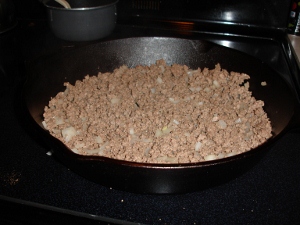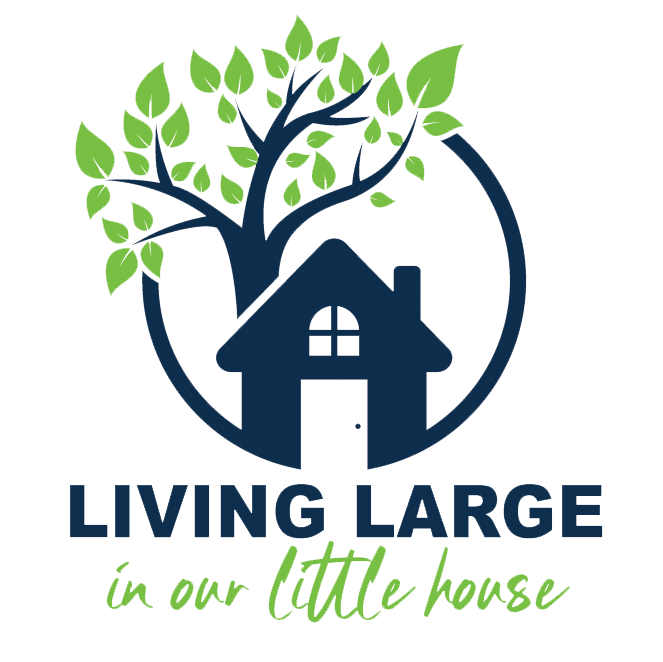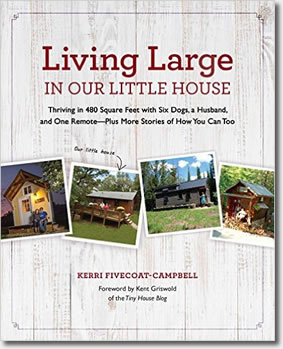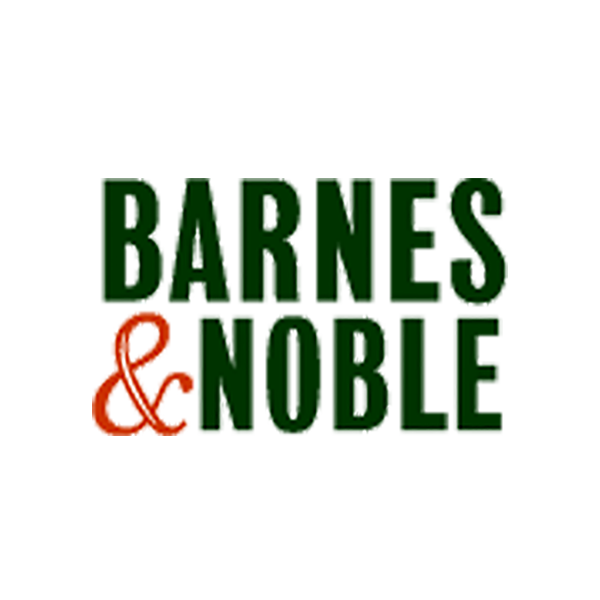Cast Iron Skillet Cooking Attempts
When Dale finally decided to share his cast iron cookware with me that he uses for campfire and Dutch Oven cooking, I knew immediately that my first dish was going to be fried chicken.
His grandmother used to make us fried chicken – and rabbit, though they tricked me into thinking it was chicken – in her cast iron skillet and it’s been nearly three decades since I had chicken that good.
I’ve been yearning to ditch the non-stick cookware I was taught to cook on at home and in 1970s and early 80s home economics classes. I was going to purchase Le Creuset set of pans, but it’s expensive and I thought it wasteful to purchase a whole new set of pans when we have a whole shelf full of cast iron we use only occasionally for outdoor cooking. (I’m still going to purchase some sauce pans from Le Creuset as the Lodge enamelware is made in China).
I’m also tired of using cookware I know is not safe for us.
The first clue for anyone on non-stick cookware is that if it over-heats, it can be fatal to birds and other small animals in the house!
When my grandfather and uncles coal mined 100 years ago, miners used the “canary” test to see if the air was safe for the miners to enter. Yet, we use cookware that emits such toxic chemicals that it kills birds!?
How crazy is that.
Dale was finally sold on using our cast iron all of the time when he read of the benefits of additional iron in the diet, but he was still wary of using it on a electric, smooth top range. He tried cooking something not long ago in the house and it stuck to the pan and he thought it might be due to the electric range.
I read Dale’s “Cast Iron Cooking for Dummies” book. I posted my intent on Living Large’s Facebook page and received some good advice.
All of our cast iron is Lodge, made in the U.S.A. (all Lodge is except for the enamel covered ware). Dale even broke out the new pre-seasoned (Lodge cast iron uses a non-toxic pre-seasoning method) 12-inch deep skillet for the chicken.
I washed the skillet in hot water, dried and oiled it. Ready, and set.
I put in the oil and preheated it for my chicken. Although some of our community on Facebook said not to turn it up too high, the book said to crisp the chicken fast at first to seal in the juices.
Before I knew it, the heat got away from me and the yummy smell of chicken frying quickly turned to chicken burning.
Of course, Dale warned me that when a cast iron skillet gets hot, you can’t cool it down immediately.
Sweating, flustered and disappointed, I finally had to try to salvage the meal in the oven (a tip I got from the book as they must have known that some people would get the skillet too hot to finish the chicken).
After 30 more minutes in the oven, the chicken was done, still juicy and crispy (only 3 pieces were actually blackened and not so badly that they couldn’t be eaten).
No sticking and no burning of the skillet, though and we used boiling water and wire brush to clean it (you don’t use soap on cast iron unless you want to season it all over).
The next night, I browned hamburger for tacos in the skillet. Low and slow and it turned out fine. Maybe I should have tried something more simple for the first time.
“It’s just going to take time,” Dale said, after the chicken fiasco.
It’s time I feel well worth it for our health and I won’t let my chicken experience stop me from pursuing this goal. I know one day I’ll serve up a bird even Grandma Wright would be proud of.
What types of pots and pans do you cook with? Do you have any cast iron cookware tips to share?









We have three work horses in the kitchen a 10 lodge cast iron skillet…a 12″ campchef one and a 14 qt cast iron dutchy ( with a coal lid). The only pans that have seen any use in the last few years that are NOT cast iron is a Caphalon Sauce pan ( the regular aluminum kind) this is used to warm soup or cook rice and a stainless pasta cooker with a strainer. 90 percent of my cooking is done in the cast stuff…we even slow roast our Turkeys in the dutchy. When I cook my ribs I steam them in the dutchy over a few maple sticks 3/4″ square by pan length this keeps stuff of the bottom.
HI, Moontree, it’s been a while since we’ve heard from you! I’m finding that most of my cooking is now done in the cast iron too. Amazing how soon I grew accustomed to it!
Cast iron is my favorite to cook with. I love making desserts in my skillet. I have great recipes for pineapple upside down cake and a pumpkin pie crumble that are made in an iron skillet. It makes them caramelize like nothing else 🙂
Oh, that sounds simply yummy! My husband wants a pineapple upside down cake. He does those well in the cast iron. Love your name, BTW!
I have a friend who, thinking she’d be helpful, used soap and a scouring pad on all the cast iron pans of one of our friends who had cooked dinner for us. What a mess that was.
Oh, my. I bet your friend was pretty upset!
Cast iron is very forgiving, tho. Even if you almost totally ruin the pan, you can always reseason it. I’ve done that numerous times!
My husband says this too, Alisa.
Kerri, Go check out Casey’s recent post at Good. Food. Stories. on cast iron skillet care. I found it really useful. Good luck.
Thanks, Sarah.
You will love your cast iron as it ages. Frankly, for the first thing to make in the cast iron I always suggest bacon so you learn how to work with it and you don’t have to rinse it, just wipe out all the grease when you’re done and you’ve got a nice coating ready for the next thing you cook. I use mine at least 5 days a week. Love it.
Thanks for the tip. Used mine for bacon the other day. You’re right, a good primer.
My mom almost always used cast iron. I started using the teflon pans but I got tired of using only certian spoon and spatulas to cook with so I’m switching back to cast iron. I have one giant pan I cook with mostly. with the change of seasons though it’s time to break out the crock pot!
Yep. Broke out the crock pot yesterday.
We do love our cast iron cookery around here. I remember my mom cooking with that brand new non-stick stuff when I was a kid. The mystery coating started chipping off and no matter! She used it anyway!
Ugh, I know, Jane. No telling what kinds of chemicals our parents implanted in our bodies! 😉
Can I put in a vote for OLD cast iron over the newer stuff? We have an old Griswold frying pan that is lighter and more nonstick than any newer pans we’ve ever had. (Actually, I’ve gotten rid of all our newer cast iron– the difference is that extreme.)
It’s hard to describe, but something about the grain of the cast iron is finer, and it weighs less than a modern-made pan of the same size. I’ve had people question why we cook on a Griswold– people collect them– but I can’t figure out how people can own them and not use them. (It’s not just that brand, though– something about the manufacturing process must’ve been different years ago.) I think we paid less than $30 for ours in a flea market– not too much more than a great deal on a current-day version.
We use our pan at least twice a day. It, and the teapot, never leave our stovetop. I clean it with a scrubby pad and water, quickly, and try not to let anything dry out in it. If I burn something, I’ll fill the bottom of the pan with an inch or two of water, heat it to boiling, then turn it off and let it soak. Everything usually comes right out once the water’s cool. (My husband does something with a pinch of kosher salt and some oil that he swears is a better way to clean it. Probably, but I don’t know the specifics on that.) We both put it on the stove and turn a burner on after washing it to evaporate all the water off of the pan completely. We’ve never had a rusting problem.
Don’t give up! They’re fabulous.
*note– I use a green scrubby pad, one of those approved for nonstick pans, not the heavy-duty kind.
Thanks, Kim. Those pans we’ve seen here in antique and flea shops are expensive (maybe because we’re right on the lake in tourist areas?) But I will look for that brand should we need more. Thanks for lending your expertise to the conversation!
I have a few pots and pans from 43 years ago, which I use for boiling stuff, but just love my old, Goodwill, etc. cast iron pieces. Never needs to be hotter than Medium. Easy to cure, periodically. Bought Calphalon, pricey, and ruined them. Very disappointing. Simple is best… my credo is “Simply, don’t lower your expectations”… that goes for life, and cookware.
Great philosophy, Nancy, I agree. Thanks for sharing! 🙂
If you ever have to strip and reseason here is a good website. I have done this with some of mine that where really bad especially on the outside.
mine came out looking brand new by the time I was done.
http://www.wikihow.com/Season-Cast-Iron-Cookware
Thank you for this website.. I have a few pieces as well and they need attention..
You are welcome….there is a video at the bottom of the website also.
Yes, Susan, thank you very much!
I grew up cooking in iron skillets and inherited one from Grandma and one from mother. More recently added a smaller omelet sized iron skillet. I have a ceramic top range and I HATE HATE HATE it. Yes, you can cook on it with an iron skillet, but since the iron is porous, the oil seeps through and burns on the glass and makes it ugly and means you need to clean frequently.
I also like the fact that you can put iron skillets right in the oven. The only downside is as I get older and my hands get weaker, it is a chore to lift the larger one.
I can see where that would be a problem for really older folks, Vera, but you’re not that old! I’m looking forward to baking in my cast iron as well.
I use my grandmother’s 100 yr old Lodge and Wagner cast iron, and have for many years.
It takes a little knowing how to handle and cook with cast iron, but I love it and do not use too much of a few of my stainless steel saute pans.
I bought last year a set of Lodge bread loaf pans, and I just love the way they brown bread. I wish I could find cast iron french bread pans but they are few and far between.
Keep working at cooking with the cast iron, Kerri, you will get the hang of it.
Thanks. I will keep at it. Thanks to you and everyone here in our little community!
I’ve got my great-grandmother’s cast iron skillet-at least 80 years old, possible 100 or more. I’ve cooked in an iron skillet all my life, so it is as natural as breathing, but yes, you don’t cool one down very quickly.
I’d be wary of that wire brush of yours. Anything too scratchy can take the seasoning off as well as soap. If I’m cooking something that isn’t too messy, I don’t wash it in water at all and will only wipe mine out with a towel. You also need to avoid cooking anything with tomatoes in it as the acid will do your seasoning no favors either.
Thanks for the tips, Frugal! It must be something to have your grandmother’s cast iron!
I’ve found not cooking at all alleviates all the worry and the messy kitchen.
Yes, but then you’re either starved or have to eat out all of the time. Who can afford that?
Yes I too use to believe that going out was the answer to all my problems in the kitchen .. but then I realize I miss out on quiet family dinners and I really missed canning and baking for my family.. I found the joy of cooking again…
🙂 !
I bought a Lodge cast iron pan last year, and have used it just a few times. I must admit, it’s a bit intimidating! But I have to plug away and get used to it. I know it’s a healthy alternative to the other types of cookware.
Is it pre-seasoned, Sheryl? Good luck!
All of my frypans are cast iron – it’s all I have ever cooked with. Most of them are old, often bought at second hand stores. I also have some cast iron cooking casseroles. Since we cook on a woodstove for much of the year I just shift the pans around to different spots to change the heat – much easier than with an electric stove that I use in the summer (altho not a smooth top. Don’t like those) I also usually swipe them round with some oil after washing and put back on the low heat to re-season. I also have some stainless steel copper bottomed pots from the Jurassic era (they were Mom’s) that I use for other stuff because acidic foods are not friends of cast iron – such as anything with tomatoes. As far as I know there is nothing harmful in them altho I have given up the “uber fear” mindset that everything is out to get me.
The additional iron that leaches out from cast iron isn’t usually a problem unless you have an iron overload in your system as some people do.
I don’t think I have ever made fried chicken, at least the type that Americans rave about. I’d love to try some altho it would have to be gluten free 🙁 It seems like such an iconic American dish like chitlins (never tried – what are they?), mac ‘n’ cheese, and okra – or maybe I’m just thinking American South?
Fried chicken is an iconic American dish, as far as I know, although the south tries to claim it as their own. 🙂 Chitlins are a different matter. South as far as I know and it is some sort of intestine. I don’t do “innards” as my mother used to call them. 🙂 Mac and cheese not necessarily southern, but fried okra definitely is. I’ve read that about tomato sauce. Since you and Mat are a fan of the stainless steel with copper bottom, I might just have to check that out. Wondering if I can find any made in the U.S. I’m in awe of your cooking on a wood stove. I did it for a week during the ice storm. That would take mastery, especially with cast iron and heat regulation. I’ve had an electric stove all of my adult life. I would prefer gas, but it’s so expensive here for propane and a pain to fill the tanks. If I have to have electric, I like the glass top, easier to keep clean, IMO.
Chitlins (or chitherlings) are pig intestinal casings that have been cleaned (very well) and cooked for a long time, usually in something like pork stock. They’re frequently eaten with hot sauce.
I’ve never eaten them but I once worked with a woman who did. They’re…pretty much an acquired taste from what I hear. I’m sure I could eat them…but knowing what they are, I think I’ll pass. I’ll get my protein somewhere else, thanks.
Sounds kind of like an unstuffed sausage. Intriguing. I’ll have to try them sometime – I’ve had worse – or maybe not worse but years ago when my DH and I were camped out in a little Mexican village they slaughtered a bull and we got there at 6 AM. Everything was taken except for something they were frying up in a pan so, being young and hungry and out in the middle of nowhere and dependent on the locals for food, we bought it – whatever it was. Turned out to be the testicles – a fact we only learned after we had eaten them. They were delicious and we were especially impressed by the fact that meat was seldom eaten but when it was – EVERYTHING was eaten.
I’m going to be closely following your fried chicken efforts. It’s the most elusive of dishes — but so wonderful when done right.
You might be following for awhile, Ruth. When I do get it to the level of where his grandmother would approve, I will let you and everyone know! 😉
IT doesn’t sound like it was a complete disaster at all. You’re very brave! Aside from the whole seasoning issue, the main reason I just cannot bring myself to buy one of these is because of how darn heavy they are. I just do not want to be struggling to get my cookware out of the cupboard. I also did not buy a heavy duty dutch oven for the same reason – I went for the aluminum one.
No, not really a disaster, but not the pretty browned chicken I had in mind. I had visions of posting photos and couldn’t even bring myself to get out the camera! I look upon the heaviness of the pots as helping to keep me in shape. 😉
I’ve had trouble learning to use cast iron too. It gets HOT and STAYS HOT much longer than other kinds of pans. So, if like me, you’re used to leaving things in the pan (even off the heat) … you can end up with overdone everything.
I’ve been using soap on mine, like a dork, so I need to re-season everything again. We “inherited” our pans from my mom and my mother-in-law. Since they are that old, I assume they were made here in the U.S. … as most stuff was, once upon a time.
I’m sure they are U.S. made, Roxanne. Uh-oh on the soap. I know it seems a little creepy not using soap, but we use boiling water to relieve fears of bacteria. I’m less scared of that than the stuff teflon has in it. Good luck! 😉
When you are frying chicken in a cast iron skillet, you pretty much have to stand over it and watch and keep turning the pieces. And if the pan gets too hot, carefully move it off the burner for a while.
When the pieces are nicely browned, put a lid on the skillet and let it finish on a lower heat. Then if you want crispy, take the lid off again to finish.
Cast iron works OK with smooth top stoves — just don’t ever drop a pan on it.
Thank you very much, Gretel. Yes, I’m afraid I’m going to drop the skillet and break the glass. I will definitely try this chicken method next time.
When I get the pan to hot, I have a cast iron trivet I put my pots on to cool down then return to the burner.
That’s a great idea, Susan!
Cooking with teflon can be safe if you follow 2 rules:
1) Never take it over medium-low heat
2) Never use anything that could scratch or mark it (silicon is about the only thing that fits that criteria).
And that pretty much makes teflon worthless, in my opinion. Not to mention that unless you’re hanging it or clustering it on top, you WILL scratch it.
We have a Lodge pan that we use to make cornbread and when we go camping (good for steaks), but otherwise, we don’t use it a lot. Cast iron takes a while to heat up and I find it difficult to regulate the temperature properly. And I hate cleaning burnt onions out of it (though it is the ideal pan to caramelize them in).
Normally, we use a set of copper-bottomed stainless steel Farberware pots and pans that my wife and I bought when we were first married…so…9 years ago. I think they were something like $150 online, but we got 3 pots with lids, 2 pans, and a dutch oven. Great stuff; good assortment. And you can cook as hot as you want on it. I’ve also noticed that with some butter and low heat, the pans are easy to season.
If I were starting out though, I’d say that you could comfortably get by with 1 large pan with 2″ sides, 1 large pot, a dutch oven, and a wok. Similarly, I find I only need 2 knives: a 7″ santoku and a paring knife. I LOVE my santokus. In fact, I bought a 4″ one for my son to use when he’s big (read: coordinated) enough to help cook in the kitchen.
Hi, Mat. Thanks for weighing in. I don’t consider anything coated with PFCs to be safe at any level. I know a lot of people who cook on stainless as well, but I’ve also had problems with sticking and burning on that as well. I’m not a great cook, I get flustered easily when doing it and need something pretty simple. The pre-seasoned cast iron stuff seemed really easy to use as far as not sticking. Regulating temps, as you say, requires some work. My next step is tossing (or donating) the plastic utensils from the kitchen and bringing in my “new” wooden handled metal ones!
Hey, no problem. I don’t advocate teflon to anyone, but it can be used if you’re extremely careful. Which I am not. And MANY people are not, but they somehow don’t know or ignore the dangers.
Like many, many things, successful only with lots of trial and error. My best suggestion for cooking with any kind of pan is to only use medium heat until you see what it does, how long it does it, and to what extent it will do it.
Note that many foods can be cooked on high, but probably shouldn’t be. Onions, peppers, and stir-fry are about all I cook hotter than 6/10.
Also, recognize that certain ingredients can change your cooking environment. For example, adding salt to veggies will actually absorb water out of the pan, getting them cooked (or burnt) faster. Minced garlic (and to a lesser extent, powdered) burns FAST, so you need to keep the environment moist. Brown garlic is wonderful…black is far from it.
Feel free to e-mail me; I’m always happy to help.
Thanks, Mat, these are all good tips that I, and I’m sure the rest of our community appreciates! I may just take you up on your offer of email help! 😉